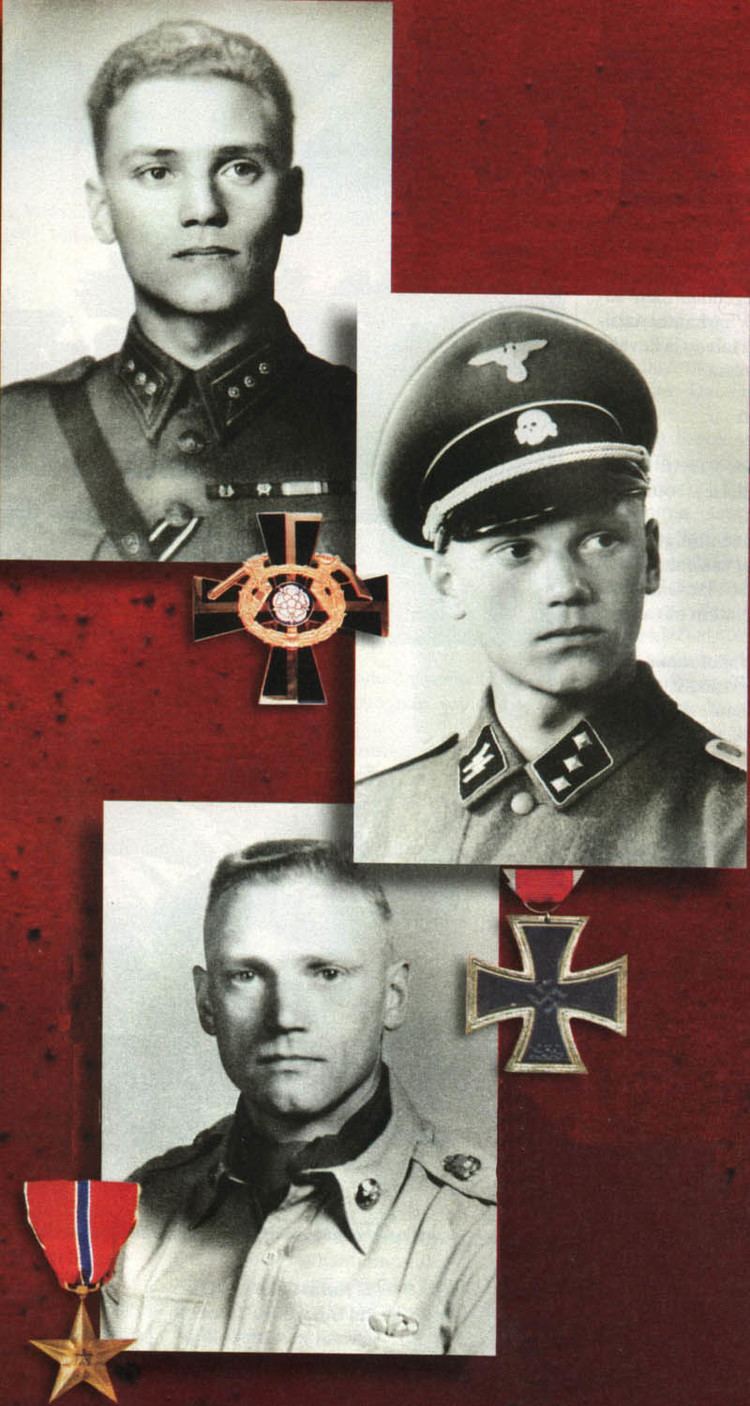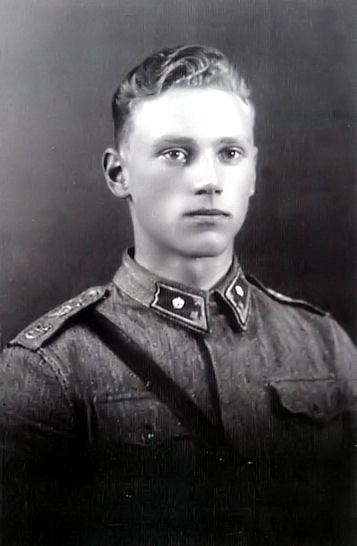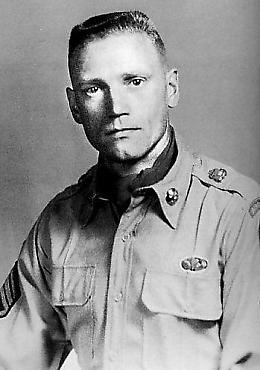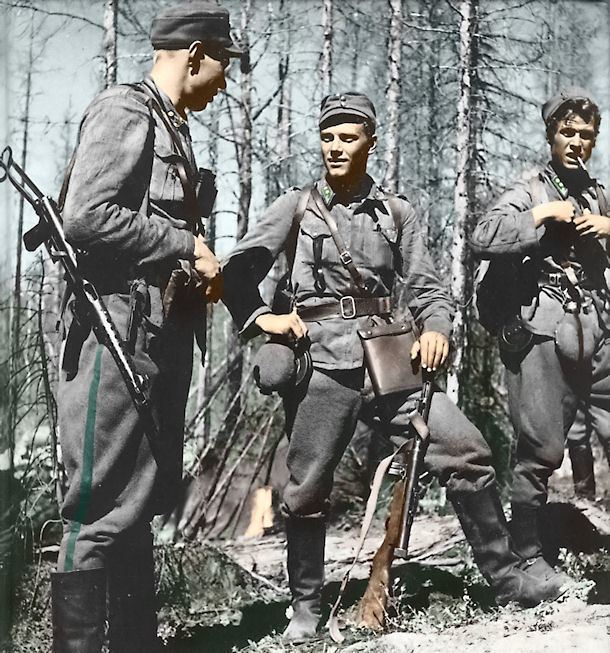Nickname(s) Lasse | Name Lauri Torni | |
 | ||
Died 18 October 1965(1965-10-18) (aged 46)Phuoc Son District, Quang Nam Province, Vietnam Service/branch Finnish ArmyWaffen SSUnited States Army Years of service 1938–1944 (Finnish Army)1945 (Waffen SS)1954–1965 (U.S. Army) | ||
The Soldier who fought in 3 Armies
Lauri Allan Törni (28 May 1919 – 18 October 1965), later known as Larry Thorne, was a Finnish Army captain who led an infantry company against the Soviet Union in the Finnish Winter and Continuation Wars and moved to the United States after World War II. He fought under three flags: Finnish, German (when he again fought the Soviets in World War II), and American (where he was known as Larry Thorne) when he served in U.S. Army Special Forces in the Vietnam War. Törni was killed in action during the Vietnam War.
Contents
- The Soldier who fought in 3 Armies
- Friends of larry thorne
- Early life and military service
- World War II
- Immigration to the United States
- United States Army
- Vietnam War and death
- Commemoration
- References

Friends of larry thorne
Early life and military service

Christened Lauri Allan Törni, he was born in Viipuri, Viipuri Province, Finland, to ship captain Jalmari (Ilmari) Törni, and his wife, Rosa (née Kosonen). He had two sisters: Salme Kyllikki (b. 1920) and Kaija Iris (b. 1922). An athletic youth, Törni was an early friend of future Olympic Boxing Gold Medalist Sten Suvio. After attending business school and serving with the Civil Guard, Törni entered military service in 1938, joining the 4th Independent Jaeger Infantry Battalion stationed at Kiviniemi; as the Winter War began in November 1939, his enlistment was extended and his unit confronted invading Soviet troops at Rautu.
World War II

During the battles at Lake Ladoga, Törni took part in the destruction of the encircled Soviet divisions in Lemetti.

His performance during these engagements were noticed by his commanders, and toward the end of the war, he was assigned to officer training where he was commissioned a Vänrikki (2nd lieutenant) in the reserves. After the Winter War, in June 1941, Törni went to Vienna, Austria for seven weeks of training with the Waffen-SS, and returned to Finland in July; as a Finnish officer, he was recognized as a German Untersturmführer.

Most of Törni's reputation was based on his successful actions in the Continuation War (1941–44) between the Soviet Union and Finland. In 1943 a unit informally named Detachment Törni was created under his command. This was an infantry unit that penetrated deep behind enemy lines and soon enjoyed a reputation on both sides of the front for its combat effectiveness. One of Törni's men was future President of Finland Mauno Koivisto. Koivisto served in a reconnaissance company under Törni's command during the Battle of Ilomantsi, which was the final Finnish-Soviet engagement of the Continuation War during July and August 1944. Törni's unit inflicted such heavy casualties on Soviet units that the Soviet Army placed a bounty on his head of 3,000,000 Finnish marks. He was decorated with the Mannerheim Cross on 9 July 1944.
The September 1944 Moscow Armistice required Finland to remove German troops from its territory and resulted in the Lapland War; also, much of the Finnish Army was demobilized along with Törni, leaving him unemployed in November 1944. In January 1945, he was recruited by a pro-German resistance movement in Finland and left for saboteur training in Germany, and to organize resistance in case Finland was occupied by the Soviet Union. The training was prematurely ended in March, but as Törni could not secure transportation to Finland, he joined a German unit to fight Soviet troops near Schwerin, Germany. He surrendered to American and British troops in the last stages of World War II and eventually returned to Finland in June 1945 after escaping a British POW camp in Lübeck, Germany.
As his family had been evacuated from Karelia, Törni sought to rejoin them in Helsinki but was arrested by Valpo, the Finnish state police; after escaping, he was arrested a second time in April 1946, and tried for treason for having joined the German army. After a trial from October to November, he received a 6-year sentence in January 1947. Imprisoned at the Turku provincial prison, Törni escaped in June, but was recaptured and sent to the Riihimäki State Prison. Finnish President Juho Paasikivi granted him a pardon in December 1948.
Immigration to the United States
In 1949 Törni, accompanied by his wartime executive officer Holger Pitkänen, traveled to Sweden, crossing the border from Tornio to Haparanda (Haaparanta), where many inhabitants were of ethnic Finnish origin. From Haparanda, Törni traveled by railroad to Stockholm where he stayed with Baroness von Essen, who harbored many fugitive Finnish officers following the war. Pitkänen was arrested and repatriated to Finland. Remaining in Sweden, Törni fell in love with a Swedish Finn, Marja Kops, and was soon engaged to be married. Hoping to establish a career before the marriage, Törni traveled under an alias as a Swedish seaman aboard the SS Bolivia, destined for Caracas, Venezuela, where Törni met one of his Winter War commanders, Finnish colonel Matti Aarnio, who was in exile having settled in Venezuela after the war. From Caracas, Törni hired on to a Swedish cargo ship, the MS Skagen, destined for the United States in 1950.
While in the Gulf of Mexico, near Mobile, Alabama, Törni jumped overboard and swam to shore. Now a political refugee, Törni traveled to New York City where he was helped by the Finnish-American community living in Brooklyn's Sunset Park "Finntown". There he worked as a carpenter and cleaner. In 1953, Törni was granted a residence permit through an Act of Congress that was shepherded by the law firm of "Wild Bill" Donovan, former head of the Office of Strategic Services.
United States Army
Törni joined the U.S. Army in 1954 under the provisions of the Lodge-Philbin Act and adopted the name Larry Thorne. In the US Army, he was befriended by a group of Finnish-American officers who came to be known as "Marttinen's Men."
With their support, Thorne was soon on his way into the Special Forces. While in the Special Forces, he taught skiing, survival, mountaineering, and guerrilla tactics. In turn he attended airborne school, and advanced in rank; attending Officer Candidate School, he was commissioned as a 1st lieutenant in the Signal Corps in 1957. He later received a regular commission and a promotion to captain in 1960. From 1958–62 he served in the 10th Special Forces Group in West Germany at Bad Tölz, where he was second in command of a search and recovery mission high in the Zagros mountains of Iran, which gained him a notable reputation. When he was in Germany, he briefly visited his relatives in Finland. In an episode of The Big Picture released in 1962 and composed of footage filmed in 1959, Thorne is shown as a lieutenant with the 10th Special Forces Group in the United States Army.
Vietnam War and death
Deploying to South Vietnam in November 1963 to support South Vietnamese forces in the Vietnam War, Thorne and Special Forces Detachment A-734 were stationed in the Tịnh Biên District and assigned to operate Civilian Irregular Defense Group (CIDG) encampments at Châu Lăng and later Tịnh Biên.
During a fierce attack on the CIDG camp in Tịnh Biên, he received two Purple Hearts and a Bronze Star Medal for valor during the battle. This attack would later be described by author Robin Moore in his book The Green Berets.
Thorne's second tour in Vietnam began in February 1965 with 5th Special Forces Group; he then transferred to Military Assistance Command, Vietnam – Studies and Observations Group (MACV–SOG), a classified U.S. special operations unit focusing on unconventional warfare in Vietnam, as a military advisor.
On 18 October 1965, he was supervising a clandestine mission which objective was to locate Viet Cong turnaround points along Ho Chi Minh trail and destroy them with airstrikes. During the operation his Vietnam Air Force CH-34 helicopter crashed in a mountainous area of Phước Sơn District, Quảng Nam Province, Vietnam, 25 miles (40 km) from Da Nang. Rescue teams were unable to locate the crash site. Shortly after his disappearance, Thorne was promoted to the rank of major.
In 1999, Thorne's remains were found by a Finnish and Joint Task Force-Full Accounting team and repatriated to the United States following a Hanoi Noi Bai International Airport ceremony that included Secretary of State Madeleine Albright and Ambassador Pete Peterson.
Formally identified in 2003, his remains were buried on 26 June 2003 at Arlington National Cemetery, section 60, tombstone 8136, along with the South Vietnam Air Force casualties of the mission recovered at the crash site.
Commemoration
In the 1990s, Törni's name became better known as a war hero, with numerous books being written about him. He was named 52nd in the Suuret Suomalaiset listing of famous Finns; in the 2006 Suomen Sotilas (Soldier of Finland) magazine listing, he was elected most courageous of the Mannerheim Cross recipients.
In Finland, the survivors, friends, and families of Detachment Törni formed the Lauri Törni Tradition Guild. The Infantry Museum (Jalkaväkimuseo) in Mikkeli, Finland, has an exhibit dedicated to Törni, as does the Military Museum of Finland in Helsinki.
Even before his death, Thorne's name was legendary in U.S. Special Forces. His U.S. memorial is the Larry Thorne Headquarters Building, 10th SFG(A), Fort Carson, Colorado. 10th Group honors him yearly by presenting the Larry Thorne Award to the best Operational Detachment-Alpha in the command. The Special Forces Association Chapter 33 in Cleveland, Tennessee is named after him.
In 2010 he was named as the first Honorary Member of the United States Army Special Forces Regiment. In the book The Green Berets by Robin Moore, the "Sven Kornie" (or Captain Steve Kornie) main character in the first chapter was based on Thorne.
In their 2013 book Tuntematon Lauri Törni [Unknown Lauri Törni], authors Juha Pohjonen and Oula Silvennoinen argue that Törni's conviction for treason was justified because the SS training he received at the end of World War II was provided to help achieve a National Socialist coup in Finland. This view is widely discredited, including by Törni Heritage Guild members Markku Moberg and Pasi Niittymäki, who acknowledge Törni faced pressure from war and alcohol, but did not support Germany, and Finnish historian Jussi Niinistö who argues that Törni's training was motivated instead by patriotism unlike the book authors who Niinistö contended stirred up hatred to promote sales of their book while disregarding "the fact that in Finland there was a genuine fear that Russia would occupy Finland."
The Swedish power metal group Sabaton released a song on their 2014 album Heroes titled "Soldier of 3 Armies" in reference to Törni's participation in three different military forces.
